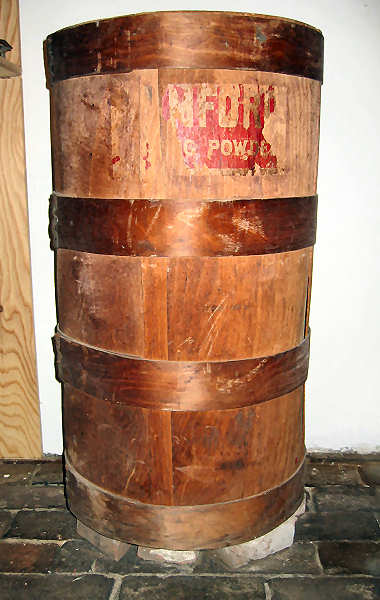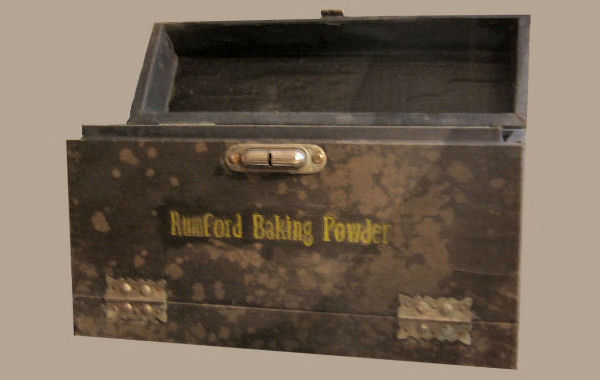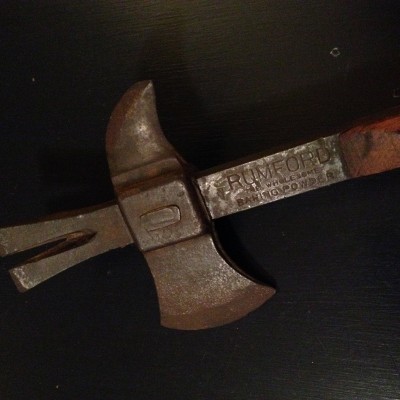In 1854 J. B. Duggan, Eben Horsford and George F. Wilson formed a chemical merchandising business in Providence. Duggan dropped out a year later. Wilson, a successful business man from Uxbridge Massachusetts, and Horsford, a Harvard chemistry professor who discovered a method of incorporating calcium and phosphates in baking powder, continued on and named the company The George F. Wilson Company.
In 1856, The Wilson Company moved to West Seekonk, MA (now Rumford, RI) and changed its name to The Rumford Chemical Works. Horsford occupied “The Rumford Chair of the Application of Science to Useful Arts” at Harvard University, hence the name.
At the beginning there were three locations which comprised The Works: Riverside on the banks of the Seekonk River in the Rumford area, The Rumford Factory in Rumford Center and Providence on South Main and South Water Streets on the Providence docks. Providence had the printing, warehouse and shipping departments and main offices. Riverside processed the bones being delivered by ships for the calcium supply and in Rumford Center was the factory, farmland and mill houses for the plant. Soon the Rumford Company owned 600 acres. This part of Seekonk became East Providence, RI in 1862.
The company continued until 1948 and was sold to the Hayden Chemical Co. Then in 1950 Hulman and Company of Terre Haute, Indiana bought the company and closed it in 1966, moving the manufacturing of Rumford Baking Powder to Terre Haute. The Essex Chemical Company Division continued until 1975.
Many of the original buildings still stand on Newman Avenue and Greenwood Avenue. The original small factory building is across from the Rumford Post Office hidden by tall trees and a fence.
Rumford Boardroom Chair
The exact date of the chairs is unknown, but we assume around 1885. For that is the year that Rumford bought the building at 58,59 and 60 South Water Street. The chairs are carved oak with leather upholstery in the Victorian style. The Boardroom was located there along with the packaging and shipping departments. The building was sold in 1927 as the Rumford Company was constructing Building 31 on the corner of Newman Avenue and Greenwood Avenue. Here were housed the general offices, Boardroom and the canning and shipping division. That building still stands.
Over the years there were many changes in Board members. Originally when the Company was incorporated in Seekonk, Massachusetts (now Rumford, RI) George Wilson was President, Edward Mandell was Treasurer, Benjamin Tucker was Clerk. In 1867 Eben Horsford was President and George Wilson was Treasurer. Between 1877 and 1878 Wilson was President and Horsford was Treasurer. The two switched places again, finally retiring Wilson as Treasurer in 1878 because his expenses caused by too much expansion were too high. The Presidents following were L.H. Farlow, Cornelius Sweetland, Andrew Fiske, Gardiner Fiske and Albert Marshall. You can find the Board members listed in the Corporate Minutes of the Rumford Corporation located in the archives of the RI Historical Society Library on Hope Street in Providence, RI
Rumford Crate Opener
This item is called the Rumford Crate opener or occasionally the Rumford Box opener. As you may know, Rumford and Horsford products were shipped in small boxes made at the factory. We have many in our collection. They are labeled for example 2 dz. 1 pound cans or 4 dz. 1/4 pound cans. They shipped Rumford and Horsford baking powder, Rumford Yeast powder, Horsford Bread Preparation and Horsford Acid Phosphate in the small boxes. It is not known if they sold or gave these tools to the merchants to use to open the boxes. You can still buy a similar tool today. They can also sometimes be referred to as a Tomahawk, because Calumet baking powder issued an almost identical tool labeled the “Calumet Tomahawk”. Our curator, Deb, was lucky enough to purchase one from eBay to add to her collection.
Thanks go to Robert and Nancy DeShelter for the information.
On loan from Deb Ormerod.
Rumford Goblet

George Francis Wilson was a school teacher and principal of the Chicago Academy in Illinois who had a desire to enter industry. He moved back to his native town of Uxbridge, MA, in 1854. That same year he entered into business in Providence with J. B. Duggan and Eben Horsford selling chemicals. In 1858 he and Horsford moved the business to Seekonk, MA (now East Providence, RI) renaming the company the Rumford Chemical Works in honor of Horsford, a chemist, who occupied the Count Rumford Chair of Physics at Harvard University. Horsford had improved on an earlier Baron Liebig formula for making a leavening agent which became known as Rumford Baking Powder. Benjamin Thompson had gone earlier to Europe from Rumford, NH (now Concord) and had endowed the Count Rumford Chair at Harvard. Horsford had studied with Liebig in Germany.
Horsford worked out of Boston, but Wilson moved to Seekonk to purchase land, manage the building of the plant, establish mill housing and farms to feed the labor force, start a company store and manage the business. Horsford and Wilson alternated back and forth as president and treasurer of the business. Before long the plant and farm encompassed three hundred acres.
Wilson became a father figure to the workers at the plant and their families. In 1865 the workers gave two silver plated goblets to Mr. Wilson for Christmas, one of which is pictured here. On it were engraved the following words:
By the employees of the
Rumford Chemical Works
As a Token of Esteem
December 25th, 1865
The goblets were in the Rumford Factory Museum until the 1960s and were not taken to Terre Haute, IN, when the company moved. Dr. Karl Holst, the last factory manager at the plant donated them to the Museum before he died.
Rumford Packaging Samples

The Rumford Company produced many products almost too numerous to mention. They also manufactured many of the containers in which the products were sold. They had their own department for manufacturing cardboard containers, tins, labels and packaging cases plus a print shop for their coupon items, paper trade cards and cooking pamphlets.
The bottles for Phosa – a soft drink, bottles for Horsford’s Acid Phosphate, carboys for Muriatic Acid and Sulphuric Acid are believed to have been made elsewhere. The early cardboard Rumford Baking Powder cans in several sizes were made at the company as well as the labels printed in several different languages depending on the country where they were going. The cardboard barrels containing Quadrofos (a textile wet cleaner), Kalye and Lytona (also cleaners) were made at the plant. Large wooden barrels for loose Baking Powder for commercial use were made in the carpenter shop.
Most famous and familiar are the many sizes of wooden boxes beautifully made with “mortise and tenon” corners in which the many sizes of Rumford Baking powder cans were shipped. These were also stenciled with the language of the country to which they were going.
Collectors obviously prize these beautiful boxes today, but the empties were put to good use before we became a “throw away” society. Because of the quality construction they made sturdy toolboxes as seen in this enlarged section of a real photo postcard showing a railroad track crew with their equipment. Other samples have had handles of various types attached and I am sure they were used to furnish many homes.
Many of the containers mentioned here are also on display at the Hunt House Museum.
Salesman’s Sample Box

From its beginning the Rumford Baking Powder Co. created a large sales organization extending across the country and the world. This country was divided into regions with traveling salesmen going door to door to the then small neighborhood markets carrying with them sample cases (as in the photo) containing sample sizes of Baking Powder cans. Sales and use of the products were tracked by a division which conducted a coupon business. Coupons were included in the the cans. Catalogs were issued to markets from which the customers could select something – usually a cooking utensil or cookbook. The customer would then send to the Rumford Co. for redemption. The company could in that way determine where their product was being used the most.
Salesmen were located throughout the world from Japan to Australia and across Europe. These coupon items and cookbooklets are very collectible today, particularly items with packaging printed in a foreign language. Sweden used baking powder in such quantity that the Rumford Co. bent to their demand and created 3/4 ounce cans. A baker could use up the small can quickly and not have the loss of rising power prevalent in a large can which was continually being opened for use.
Rumford Water Tower Finial

To supply the factory and associated housing Rumford Chemical Works built a water tower next to the Rumford Center plant. It was painted to resemble a huge Baking Powder Can which loomed over the neighborhood for years. Many kids grew up looking at the lighted can at night through their bedroom windows. It was a source of comfort and stability. Although the tower was dismantled the finial is now on display at the Hunt house museum.

